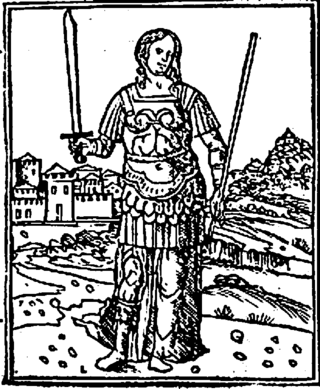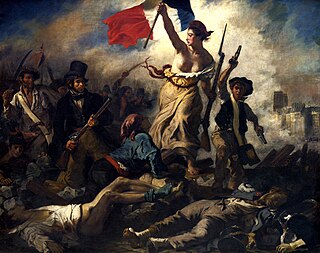This article concerns the period 319 BC – 310 BC.

Myrrha, also known as Smyrna, is the mother of Adonis in Greek mythology. She was transformed into a myrrh tree after having intercourse with her father, and gave birth to Adonis in tree form. Although the tale of Adonis has Semitic roots, it is uncertain where the myth of Myrrha emerged from, though it was probably from Cyprus.

Antigonus I Monophthalmus was a Macedonian Greek general and successor of Alexander the Great. A prominent military leader in Alexander's army, he went on to control large parts of Alexander's former empire. He assumed the title of basileus (king) in 306 BC and reigned until his death. He was the founder of the Antigonid dynasty, which ruled over Macedonia until its conquest by the Roman Republic in 168 BC.

Semiramis was the legendary Lydian-Babylonian wife of Onnes and of Ninus, who succeeded the latter on the throne of Assyria, according to Movses Khorenatsi. Legends narrated by Diodorus Siculus, who drew primarily from the works of Ctesias of Cnidus, describe her and her relationships to Onnes and King Ninus.

Ferdinand Victor Eugène Delacroix was a French Romantic artist regarded from the outset of his career as the leader of the French Romantic school.

Ashurbanipal was the king of the Neo-Assyrian Empire from 669 BC to his death in 631. He is generally remembered as the last great king of Assyria. Ashurbanipal inherited the throne as the favored heir of his father Esarhaddon; his 38-year reign was among the longest of any Assyrian king. Though sometimes regarded as the apogee of ancient Assyria, his reign also marked the last time Assyrian armies waged war throughout the ancient Near East and the beginning of the end of Assyrian dominion over the region.

Sardanapalus was, according to the Greek writer Ctesias, the last king of Assyria, although in fact Ashur-uballit II holds that distinction.
Arbaces was the name of more than one person of classical antiquity:

Eudemus was one of Alexander the Great's generals. In 326 BC he was appointed by Alexander as one of the commanders of the troops in India along with Peithon, Porus and Taxiles. After Alexander's death, Eudemus assassinated Porus and effectively controlled Alexander's northern Indian territories until he became involved in the Wars of the Diadochi during which he was captured and killed by Antigonus.

The Death of Sardanapalus is an oil painting on canvas by Eugène Delacroix, dated 1827. It currently hangs in the Musée du Louvre, Paris. A smaller replica, painted by Delacroix in 1844, is now in the Philadelphia Museum of Art.
In Greek mythology, Corybas is the son of Iasion and the goddess Cybele, who gave his name to the Corybantes (Koribantes), or dancing priests of Phrygia. The Korybantes were associated with Orpheus, another son of Apollo and a Mousa, founder of the closely related Orphic Mysteries.

The Partition of Babylon was the first of the conferences and ensuing agreements that divided the territories of Alexander the Great. It was held at Babylon in June 323 BC. Alexander’s death at the age of 32 had left an empire that stretched from Greece all the way to India. The issue of succession resulted from the claims of the various supporters of Philip Arrhidaeus, and the as-of-then unborn child of Alexander and Roxana, among others. The settlement saw Arrhidaeus and Alexander’s child designated as joint kings with Perdiccas serving as regent. The territories of the empire became satrapies divided between the senior officers of the Macedonian army and some local governors and rulers. The partition was solidified at the further agreements at Triparadisus and Persepolis over the following years and began the series of conflicts that comprise the Wars of the Diadochi.

The French composer Hector Berlioz made four attempts at winning the Prix de Rome music prize, finally succeeding in 1830. As part of the competition, he had to write a cantata to a text set by the examiners. Berlioz's efforts to win the prize are described at length in his Memoirs. He regarded it as the first stage in his struggle against the musical conservatism represented by the judges, who included established composers such as Luigi Cherubini, François-Adrien Boieldieu and Henri-Montan Berton. Berlioz's stay in Italy as a result of winning the prize also had a great influence on later works such as Benvenuto Cellini and Harold en Italie. The composer subsequently destroyed the scores of two cantatas almost completely and reused music from all four of them in later works. There was a revival of interest in the cantatas in the late 20th century, particularly Cléopâtre, which has become a favourite showcase for the soprano and mezzo-soprano voice.

Jean Pierre Félicien Mallefille was a French novelist and playwright.

Sardanapalo or Sardanapale, S.687, is an unfinished opera by Franz Liszt based on the 1821 verse play Sardanapalus by Lord Byron. Liszt was ambitious for his project, and planned to dovetail his retirement as a virtuoso with the premiere of his opera. He worked on it intermittently between 1845 and 1852, once declaring it 'well on the way toward completion,' but ceased work on it thereafter. The first act had been completed in a detailed, continuous particell, but there is no evidence of any music being notated for Acts 2–3. As an Italian opera, it would almost certainly have been called Sardanapalo, though Liszt referred to it as Sardanapale in his French correspondence. The music Liszt completed remained silent until 2016 when British musicologist David Trippett first established the legibility of Liszt's N4 manuscript, and produced both a critical edition and realized an orchestral performing edition. This received its world premiere in Weimar on 19 August 2018.

Le sette folgori di Assur is a 1962 Italian peplum colour film set in ancient Mesopotamia. The film anachronistically portrays as contemporaries several figures who historically lived hundreds of years apart.

Marino Faliero, Doge of Venice is a blank verse tragedy in five acts by Lord Byron, published and first performed in 1821.

The Two Foscari: An Historical Tragedy (1821) is a verse play in five acts by Lord Byron. The plot, set in Venice in the mid-15th century, is loosely based on the true story of the downfall of doge Francesco Foscari and his son Jacopo. Byron's play formed the basis of Verdi's opera I due Foscari.

Romanticism was a literary and artistic movement that appeared in France in the late 18th century, largely in reaction against the formality and strict rules of the official style of neo-classicism. It reached its peak in the first part of the 19th century, in the writing of François-René de Chateaubriand and Victor Hugo, the poetry of Alfred de Vigny; the painting of Eugène Delacroix; the music of Hector Berlioz; and later in the architecture of Charles Garnier. It was gradually replaced beginning in the late 19th century by the movements of Art Nouveau, realism and modernism.
Artaeus, is the legendary sixth king of Media mentioned by Ctesias, who succeeded Arbian, and not Sardanapalus. Artaeus was the father of Artachaees and Azanes.

















